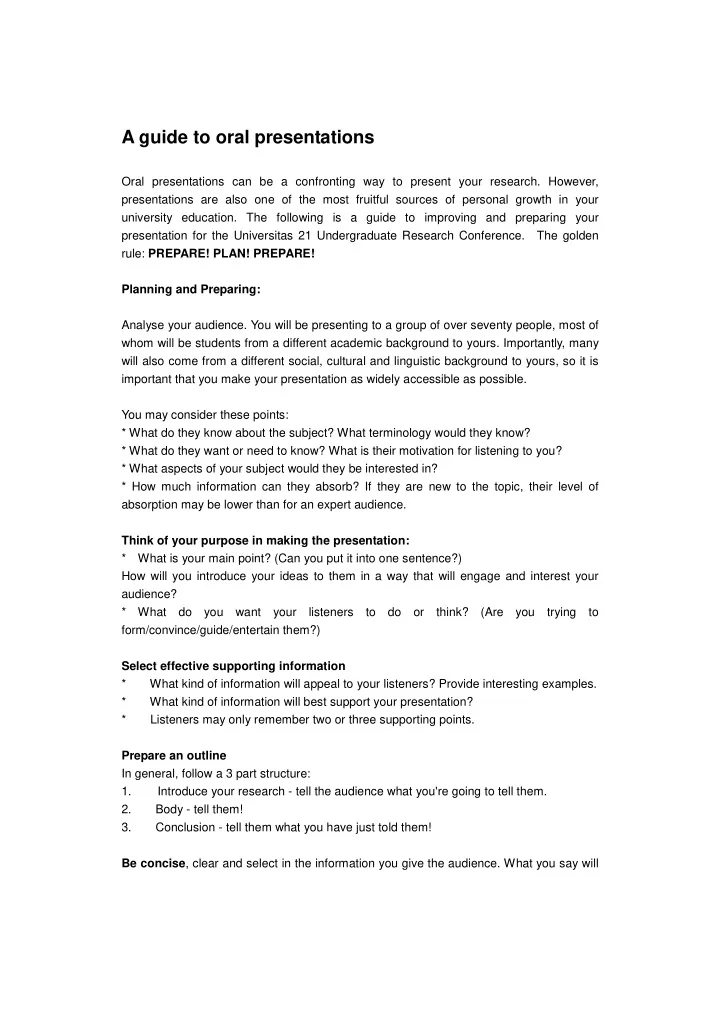

A guide to oral presentations Oral presentations can be a confronting way to present your research. However, presentations are also one of the most fruitful sources of personal growth in your university education. The following is a guide to improving and preparing your presentation for the Universitas 21 Undergraduate Research Conference. The golden rule: PREPARE! PLAN! PREPARE! Planning and Preparing: Analyse your audience. You will be presenting to a group of over seventy people, most of whom will be students from a different academic background to yours. Importantly, many will also come from a different social, cultural and linguistic background to yours, so it is important that you make your presentation as widely accessible as possible. You may consider these points: * What do they know about the subject? What terminology would they know? * What do they want or need to know? What is their motivation for listening to you? * What aspects of your subject would they be interested in? * How much information can they absorb? If they are new to the topic, their level of absorption may be lower than for an expert audience. Think of your purpose in making the presentation: * What is your main point? (Can you put it into one sentence?) How will you introduce your ideas to them in a way that will engage and interest your audience? * What do you want your listeners to do or think? (Are you trying to form/convince/guide/entertain them?) Select effective supporting information * What kind of information will appeal to your listeners? Provide interesting examples. * What kind of information will best support your presentation? * Listeners may only remember two or three supporting points. Prepare an outline In general, follow a 3 part structure: 1. Introduce your research - tell the audience what you're going to tell them. 2. Body - tell them! 3. Conclusion - tell them what you have just told them! Be concise , clear and select in the information you give the audience. What you say will
have much greater impact if you are not cramming together and rushing through large volumes of information. Prioritise, It is important to have time to repeat key points in different ways, and to provide an effective introduction and conclusion. Prepare an introduction When your introduction is over, your audience should be interested, know what your main point is, and know how you're going to explain it. Therefore, does your introduction... 1. arouse interest in the topic? 2. provide context, i.e. background and definitions? 3. clearly state the main point of the talk? Prepare a conclusion Listeners often rate a presentation on the quality of its ending, so prepare clear, succinct closing comments that catch the listener's attention. Delivery – this is very important! The delivery of your presentation is of utmost importance in the overall effectiveness of your presentation. You can have the most interesting research and a well-prepared paper but it is the way you present it that will engage your audience and take them with you. Here are some tips: * Practice your presentation aloud (it will not help if you just say it in your head). * When you are presenting, don't read your text word for word from a page. Use cue cards with simple dot points on which you elaborate orally as you go. This method is much more engaging as you are speaking directly to your audience. * Let the audience know what's coming: let them know the structure of your talk, use linking words between sections and keep them up-to-date on where you are up to. * Audience attention span is short, so break up long sections of information with questions, feedback, activities, and repetition of important points. *Do not rush. Speak more slowly and clearly than you normally would. Provide extra emphasis through intonation and body language. * Be aware of body language: avoid annoying habits such as talking with your hands in your pockets, slouching, scratching, fiddling, "um, er...". * Practice maintaining eye-contact with a group of people. It is the surest way to capture the attention of your audience. Question time Your audience will be given the opportunity to question you on your research at the conclusion of your presentation. It is worth considering the following points: * How will you deal with audience questions? What if you can't answer the question?
* How will you respond to criticism? * What if the audience misunderstands what you say? If you are using a PowerPoint presentation: * Visuals must convey your point clearly and simply. * Do not over-use visuals (a trap when using PowerPoint). The visuals are not the presentation, their purpose is simply to summarise or illustrate your main points. * Familiarise yourself with the slides, and practise delivering your presentation accompanied by the slideshow. * Time your presentation using the slideshow. Consider using fewer slides (Like around 5-10) for a ten minute presentation, and speak to the slides rather than racing through as many slides as possible. This is distracting and you will lose the impact of your information, and quite possibly the attention of your audience. When presenting… * Nervousness is normal - combat it by knowing your content and practising it! Convert what nervousness remains into enthusiasm and focus. * Breathe. Pause between points. Emphasise key ideas/information. * Establish contact with the audience - talk with them before your presentation. * Walk purposefully and confidently to the front of the lecture room. * Remember, the purpose of oral presentations is to communicate a topic as interestingly and succinctly as possible, so be expressive and concise.
Recommend
More recommend